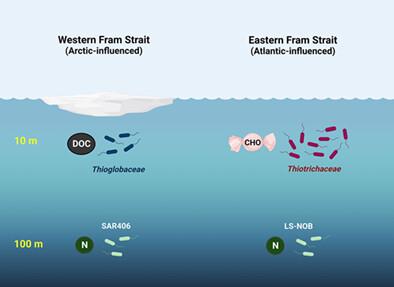当前位置:
X-MOL 学术
›
Environ. Microbiol.
›
论文详情
Our official English website, www.x-mol.net, welcomes your feedback! (Note: you will need to create a separate account there.)
The Arctic summer microbiome across Fram Strait: Depth, longitude, and substrate concentrations structure microbial diversity in the euphotic zone
Environmental Microbiology ( IF 5.1 ) Pub Date : 2024-01-24 , DOI: 10.1111/1462-2920.16568 Matthias Wietz 1, 2 , Anja Engel 3 , Simon Ramondenc 1, 4 , Matomo Niwano 1, 2 , Wilken‐Jon von Appen 5 , Taylor Priest 2, 6 , Anabel von Jackowski 3 , Katja Metfies 7, 8 , Christina Bienhold 1, 2 , Antje Boetius 1, 2, 4
Environmental Microbiology ( IF 5.1 ) Pub Date : 2024-01-24 , DOI: 10.1111/1462-2920.16568 Matthias Wietz 1, 2 , Anja Engel 3 , Simon Ramondenc 1, 4 , Matomo Niwano 1, 2 , Wilken‐Jon von Appen 5 , Taylor Priest 2, 6 , Anabel von Jackowski 3 , Katja Metfies 7, 8 , Christina Bienhold 1, 2 , Antje Boetius 1, 2, 4
Affiliation

|
The long-term dynamics of microbial communities across geographic, hydrographic, and biogeochemical gradients in the Arctic Ocean are largely unknown. To address this, we annually sampled polar, mixed, and Atlantic water masses of the Fram Strait (2015–2019; 5–100 m depth) to assess microbiome composition, substrate concentrations, and oceanographic parameters. Longitude and water depth were the major determinants (~30%) of microbial community variability. Bacterial alpha diversity was highest in lower-photic polar waters. Community composition shifted from west to east, with the prevalence of, for example, Dadabacteriales and Thiotrichales in Arctic- and Atlantic-influenced waters, respectively. Concentrations of dissolved organic carbon peaked in the western, compared to carbohydrates in the chlorophyll-maximum of eastern Fram Strait. Interannual differences due to the time of sampling, which varied between early (June 2016/2018) and late (September 2019) phytoplankton bloom stages, illustrated that phytoplankton composition and resulting availability of labile substrates influence bacterial dynamics. We identified 10 species clusters with stable environmental correlations, representing signature populations of distinct ecosystem states. In context with published metagenomic evidence, our microbial-biogeochemical inventory of a key Arctic region establishes a benchmark to assess ecosystem dynamics and the imprint of climate change.
中文翻译:

横跨弗拉姆海峡的北极夏季微生物组:深度、经度和底物浓度构成了真光带的微生物多样性
北冰洋跨地理、水文学和生物地球化学梯度的微生物群落的长期动态在很大程度上是未知的。为了解决这个问题,我们每年对弗拉姆海峡的极地、混合和大西洋水团(2015-2019 年;5-100 m 深度)进行采样,以评估微生物组组成、底物浓度和海洋学参数。经度和水深是微生物群落变异的主要决定因素(~30%)。细菌α多样性在低光度极地水域中最高。群落组成从西向东转移,例如,达达细菌目和硫毛菌目分别在受北极和大西洋影响的水域中盛行。与弗拉姆海峡东部叶绿素最高的碳水化合物相比,溶解有机碳的浓度在西部达到峰值。由于采样时间在浮游植物水华早期(2016/2018 年 6 月)和晚期(2019 年 9 月)之间存在差异,说明浮游植物组成和由此产生的不稳定底物可用性会影响细菌动态。我们确定了 10 个具有稳定环境相关性的物种簇,代表不同生态系统状态的特征种群。根据已发表的宏基因组证据,我们对北极关键地区的微生物生物地球化学清单建立了评估生态系统动态和气候变化影响的基准。
更新日期:2024-01-24
中文翻译:

横跨弗拉姆海峡的北极夏季微生物组:深度、经度和底物浓度构成了真光带的微生物多样性
北冰洋跨地理、水文学和生物地球化学梯度的微生物群落的长期动态在很大程度上是未知的。为了解决这个问题,我们每年对弗拉姆海峡的极地、混合和大西洋水团(2015-2019 年;5-100 m 深度)进行采样,以评估微生物组组成、底物浓度和海洋学参数。经度和水深是微生物群落变异的主要决定因素(~30%)。细菌α多样性在低光度极地水域中最高。群落组成从西向东转移,例如,达达细菌目和硫毛菌目分别在受北极和大西洋影响的水域中盛行。与弗拉姆海峡东部叶绿素最高的碳水化合物相比,溶解有机碳的浓度在西部达到峰值。由于采样时间在浮游植物水华早期(2016/2018 年 6 月)和晚期(2019 年 9 月)之间存在差异,说明浮游植物组成和由此产生的不稳定底物可用性会影响细菌动态。我们确定了 10 个具有稳定环境相关性的物种簇,代表不同生态系统状态的特征种群。根据已发表的宏基因组证据,我们对北极关键地区的微生物生物地球化学清单建立了评估生态系统动态和气候变化影响的基准。



























 京公网安备 11010802027423号
京公网安备 11010802027423号